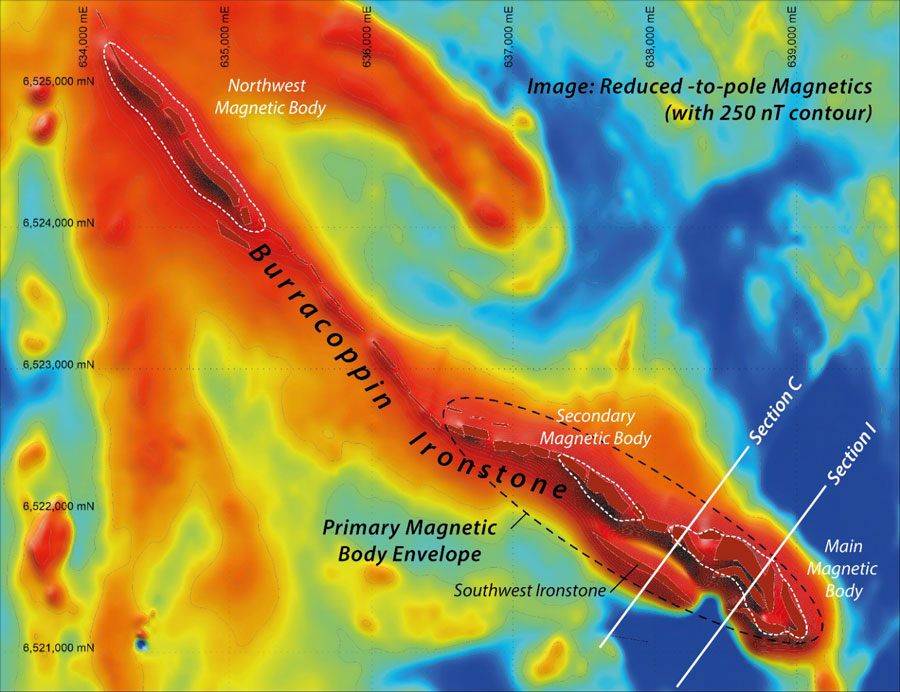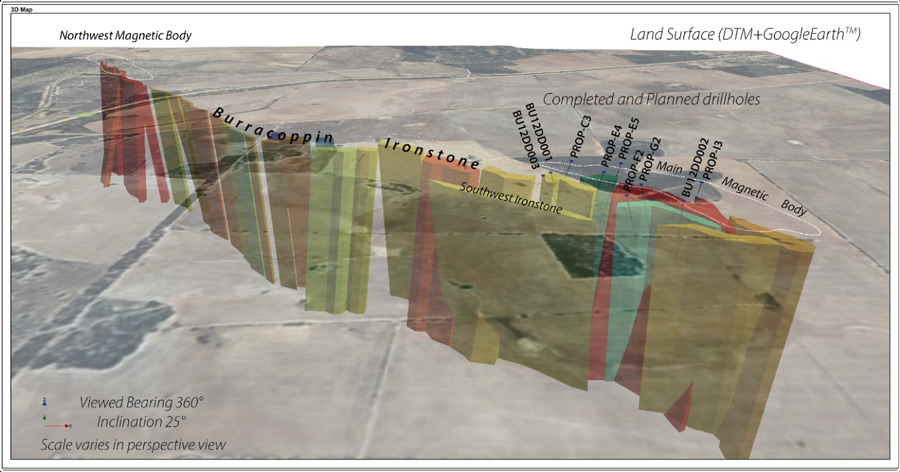Home > Projects > Burracoppin Iron > Burracoppin Magnetite Deposit
Mining – Burracoppin Magnetite Deposit
Opportunity: Establish a Mineral Resource at the Burracoppin Magnetite Deposit
and build a mine to produce 1.6Mtpa iron concentrate for smelting into Pig Iron.
| LOCATION |
|
| MINERALISATION |
|
| BENEFICIATION Indicative only, based on results from early testing |
|
The magnetite deposit is well positioned with existing open access infrastructure including, rail and port facilities.
A recent study by CSIRO using advanced modelling of the magnetic field associated with the deposit is being used to guide the Company’s planned resource definition drilling (refer to ASX release 29/04/2022).
Metallurgical testwork conducted on core samples from 3 holes drilled into the Burracoppin magnetite deposit has identified mineralisation well suited to HIsmelt. The testwork to date indicates the Burracoppin mineralisation can produce an iron concentrate of at least 65% Fe and low impurities at a grind size of 80% passing 150 micron (refer to ASX releases, 18/01/2013 and 17/11/2014 ).

Further drilling and metallurgical testwork is planned to establish Indicated Resources which, if achieved, will enable financials for the mining and production of iron concentrate for the smelter to be estimated.
H & S Consultants is assisting with planning the drilling and metallurgical work (refer to ASX release 12/02/2021). A drill program planned prior to receiving the results from the CSIRO study has been updated to incorporate testing the deposit geometry interpreted by the CSIRO study.
The drilling is focused in the region of the 3 existing holes located towards the southeastern end of the deposit, which provided the samples for the metallurgical work completed to date (drill holes BU12DD001, BU12DD002 and BU12DD003 drilled in 2012).
The planned drilling is designed to accommodate flexibility to allow testing two alternative mineralisation models. One model, based on extrapolations of geological data recovered from the 2012 drilling, is a shallow southwest dipping set of tabular bodies (refer to ASX release 12/02/2021 ). An alternative model, based on the CSIRO’s MagResource method, is of steeply northeast dipping bodies (refer to ASX release 29/04/2022 ). The initial drilling incorporates testing the MagResource method.

Holes drilled in 2012 are located on Section C (BU12DD001 & 3) and Section I (BU12DD002) (see figure 3).

Should the drilling and further metallurgical testwork succeed in establishing an Indicated Resource of sufficient size the next steps would involve expanding the work to Pre-Feasibility Study and potentially further extending to Bankable Feasibility Study (BFS) followed by construction of mine and processing facilities to produce 1.6Mtpa iron concentrate for use as feed for the planned smelter.
Alternatively, the concentrate product could be sold into the iron ore market or, if upgraded to Direct Reduction Magnetite Concentrate, marketed to be processed into pellets to make direct reduced iron for Electric Furnaces (refer to ASX release 30/10/2023 ).
CSIRO in research study of
Burracoppin Magnetite Deposit in WA.
A collaboration with CSIRO investigated new ways to determine iron (magnetite) resource estimates that can rely more on geophysics than information solely from drill holes. The project included subsampling and analysing previously drilled core from the deposit to determine the physical properties (e.g. magnetisation and density) of the Burracoppin Magnetite deposit, and using those results to constrain a detailed 3-D magnetic/density model of the mineralisation – the CSIRO MagResource method (refer to ASX release 29/04/2022 ).
The final report for the CSIRO MagResource method for the Burracoppin Magnetite Deposit was received in April 2022. It is hoped the drilling Reedy Lagoon is planning for the project can provide a case study for the method.
If shown to be successful, our work with CSIRO may help pioneer a new resource determination tool capable of estimating a resource with far less drilling than is currently required, saving much expense and reducing ground disturbance. The project was made possible through CSIRO Kick-Start, an initiative that provides funding and support for innovative Australian start-ups and small businesses to access CSIRO’s research expertise and capabilities.
